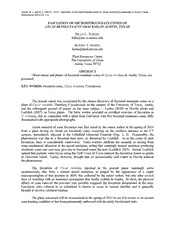
Fasciation of microsporangiate cones of Cycas revoluta (Cycadaceae) in Austin, Texas PDF
Preview Fasciation of microsporangiate cones of Cycas revoluta (Cycadaceae) in Austin, Texas
Fasciation of microsporangiate cones of Cycas revoluta (Cycadaceae) ii FASCIATION OF MICROSPORANGIATE CONES OF CYCAS REVOLUTA (CYCADACEAE) IN AUSTIN, TEXAS Robert Harms T. [email protected] Plant Resources Center The Univerrsity of Texas Austin, Texas 78712 ABSTRACT Observations and photos of fasciated staminate cones of Cycas revoluta in Austin, Texas, are presented. KEY WORDS: fasciated cones, Cycas revoluta, Cycadaceae The present report was occasioned by the chance discovery of fasciated staminate cones on a plant of Cycas revoluta Thunberg (Cycadaceae) on the campus of the University of Texas, Austin, — and the subsequent perusal of papers on the same subject Lasley (20 10) on Florida plants and Loeblich (2007) on Texas plants. The latter worker provided an excellent overview of fasciation in C revoluta. this in connection with a plant from Galveston with five fasciated staminate cones, fully documented with appropriate photographs. Austin material of such fasciation was fust noted by the senior author in the spring of 2010 UT from a plant having six fused (or fasciated) cones occurring on the southern entrance to the campus, immediately adjacent to the Littlefield Memorial Fountain (Figs. 1, 2). Presumably, the n ^u phenom^Kfn wis dut. a ns-Mted stan apt. ss J sed by Loeblich. As to the cause of such fasciation, there considerable controversy. Some workers attribute the anomaly as arising from is some mechanical alteration at the apical meristem, noting that seemingly normal meristem producing may staminate cones one year give rise to fasciated cones the next (Loeblich 2007). Indeed, Loeblich opined that periodic wind forces along the Gulf Coast of Texas induced the fasciation found on plants at Galveston Island. Lasley, how^ever, thought that an unseasonably cold winter in Florida induced phenomenon. the The fasciation of Cycas revoluta reported in the present paper seemingly arose spontaneously, this from a normal apical meristem, as judged by the appearance of a single microsporangium at that position in 2009, this collected by the senior author, but only after several days of wrestling with an immature sporangium that finally yielded trophy. In short, the physical its efforts of cone removal the previous year possibly triggered the fasciation documented in the next. Fasciation (also referred to as cristation) known to occur in various families and generally is is thought to involve cytokinin balance. The plant concerned will be re-examined in the spring of 201 1 to see if it reverts to its normal cone-bearing condition or has been permanently embossed with its newly fasci(n)ated stale. ACKNOWLEDGEMENTS Many thanks to Nancy Elder, Life Sciences Librarian at The University of Texas, for help in procurement of literature and to Guy Nesom and Jana Kos for helpful suggestions on the manuscript itself LITERATURE CITED Loeblich, A.R. 2007. Fasciation of the stem and microsporangiate cone of the gymnosperm, Cycas revoluta Thunberg, 1782 (Cycadaceae) in Texas. Encephalartos 90: 21-24. — A Lasley, L. 201 0. crested Sago Palm Cycas revoluta var. cristata: 1 in a million. PalmTalk: International Palm Society Forum, 15 June 2010. Figure Cycas revoluta on the University of Texas campus. 30 June 2010. 1. Turner and Hariri; Fasclation in Cycas<\ Figure 2. Cycas rewluta: six fasciated cones, 15 June 2
